History of portable game consoles. Part 1.1 (1990s)
Hi, Habr!
In the comments to my article The history of portable game consoles. Part 1 (Until 2000) you indicated to me the absence of some game consoles that were available in the 1990s. Therefore, I wrote this supplement.
The list of consoles this time:
')
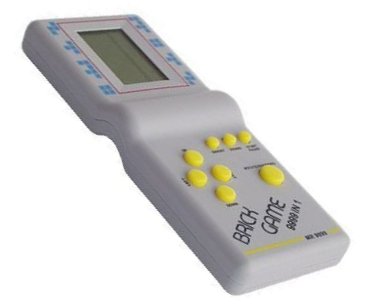
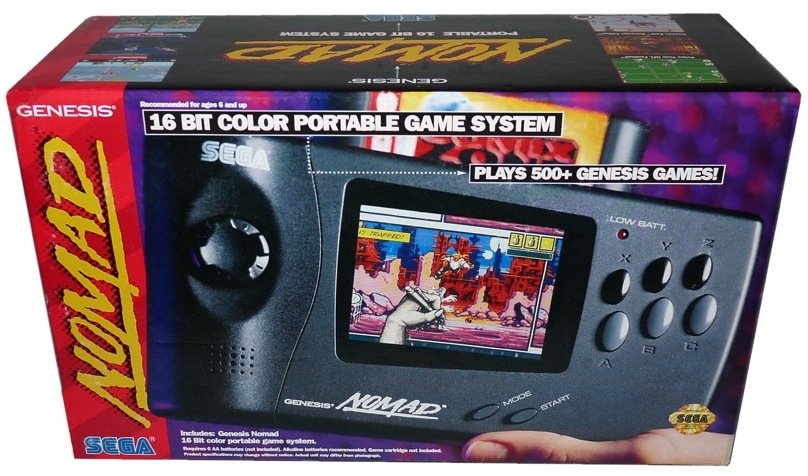

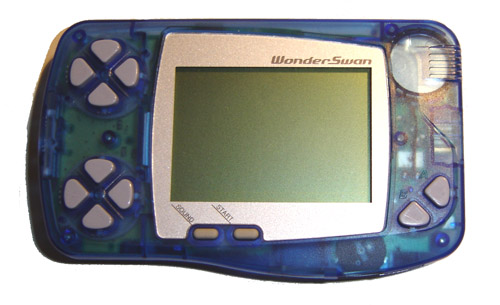
I wonder if there are people in Habré who have never played Brick Game? In common, this toy was called Tetris. Contained from two to infinity games. As it turned out recently, it is possible to finish Tetris in order to increase the number of games - read this habrapost .
Powered by two finger batteries. Form factors - a wild number: now the Chinese are stylizing it for other consoles and for mobile phones. And, of course, the classic "brick", so popular in the 1990s in Russia. Sold so far.
The popularity of the toy has declined due to other consoles.

I told about the Sega Game Gear in the last article, but I missed Sega Nomad. Although now this prefix is one of the most popular among rare consoles, as one reader noted.
Sega Nomad was released in 1995 at a price of $ 180. Sold a total of about a million copies.
The console is equipped with a 3.5-inch color display and a removable compartment for six finger-type batteries.
One of its main features - the lack of games created specifically for her. Instead, it was necessary to insert cartridges from the usual Sega Mega Drive / Genesis home console into the console. I think many owners of Shogi have dreamed of this. In addition, it was possible to connect this set-top box to the TV, insert an ordinary joystick from a shogi into a special port and play together. Interestingly, even when connected to a TV on the display, you can watch the game.
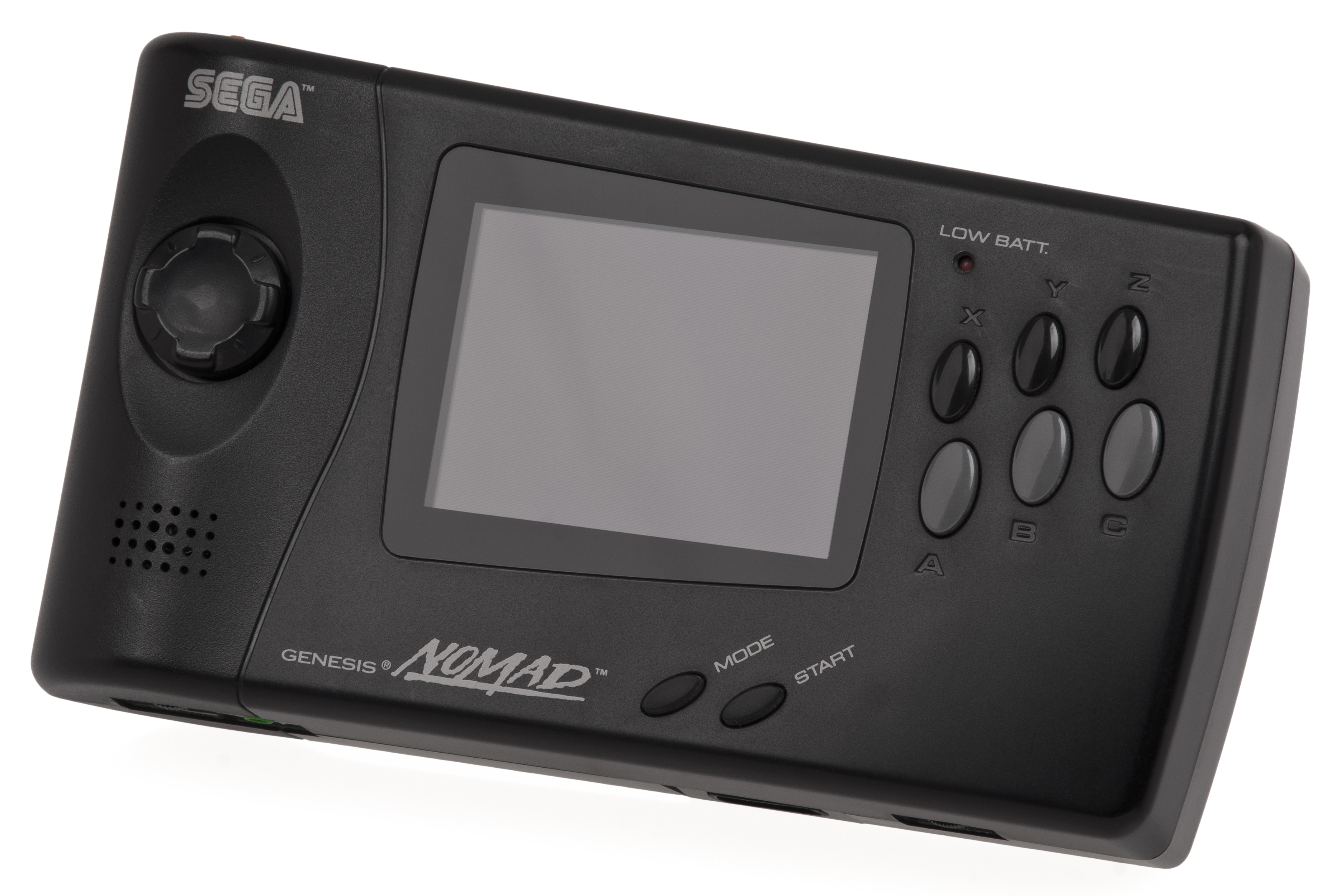


By portable consoles can be attributed, and Virtual Boy, released in 1994 by Nintendo. Although for this console, after all, a table was needed, and it cannot be used while moving - because it blocks peripheral vision.
It was the first console from Nintendo, capable of three-dimensional graphics. It uses technology similar to the “virtual reality helmet” - you immerse your face in the device, and two monochrome (black and red) projectors transmit the image separately for each eye.
The system has a resolution of 384x224 pixels, although it does not contain a full LED matrix with this resolution. Instead, two 1x224 lines move at high speed.
The system expected failure. The users mostly had a neck pain. Yes, and the black and red image is not pleased.
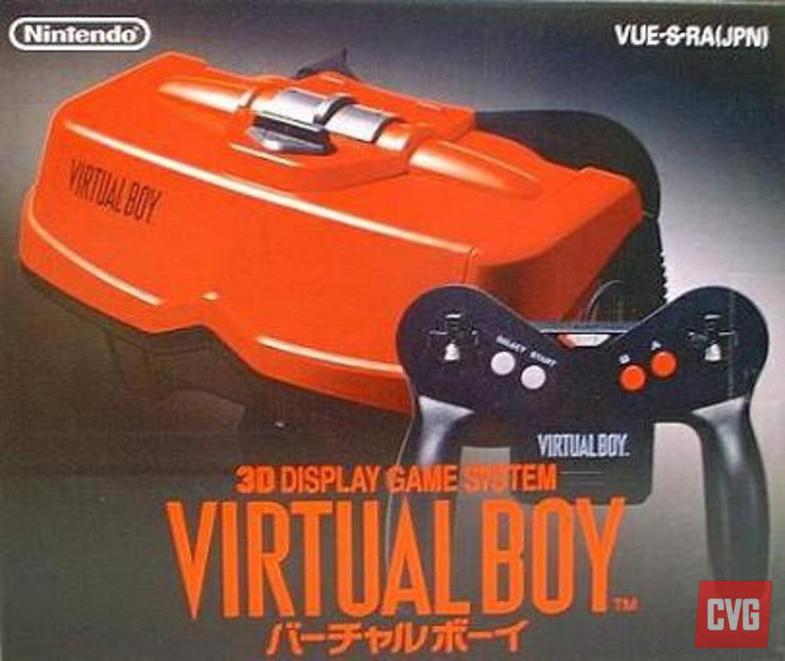


Portable console Game.com was released in 1997. Only 300,000 copies were sold - so-so results. But, nevertheless, this toy carried a number of interesting things in itself:
1) Touchscreen black and white display with adjustable contrast.
2) Two slots for cartridges.
3) Port for connecting to a modem.
4) Ability to connect to the outlet.
In the kit was a stylus: it is he at the bottom of the front panel.

Overview of the console in English.
Among the games released for this console were Duke Nukem 3D, Mortal Kombat Trilogy and Resident Evil 2. In this video - the gameplay of Resident Evil 2. Yes, yes, on the black and white display.
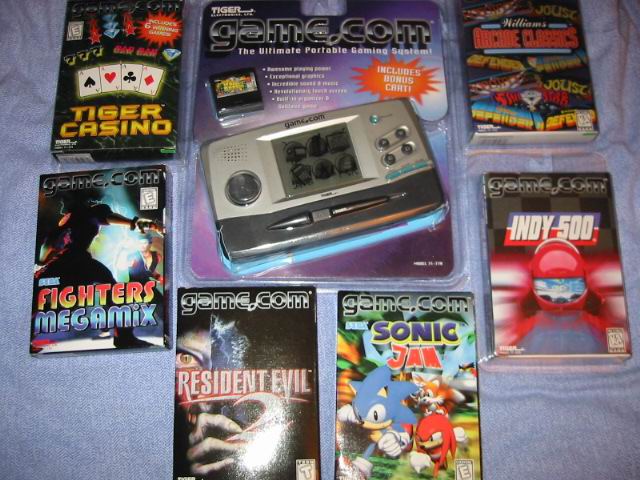
In 1998, the fifth prefix of the Sega company, named DreamCast, was released. For it is issued a memory card Visual Memory Unit. The map is not quite ordinary: it is equipped with a 48 x 32 dot LCD monochrome display, and the ability to play mini-games directly on it. In the case of Resident Evil, this map showed health - so it was not necessary to go to the “Weapon” menu during the game. VMU was inserted directly into the joystick.
More about DreamCast I wrote in the history of game consoles in advertising. Part 3

An example of using VMU in the game Sakura Wars III.
Another example of using a memory card as a separate gaming device is the Pocket Station device released by Sony in 1999.
The device is equipped with a liquid crystal display and a speaker. There is also a clock and a calendar. Information users can share via infrared. Toys for Pocket Station are recorded from discs with games.
The resolution of the monochrome display is 32 x 32 dots.
Pocket Station was released in the Japanese market and did not appear in Europe and the USA.
A mimic ad with a monkey.
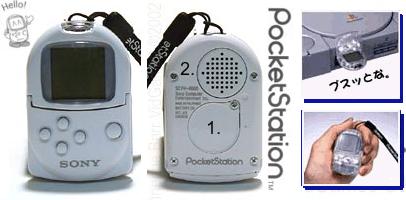
The Neo Geo Pocket portable console was released in 1998 in Japan and several other Asian countries without seeing the European and American markets. She lived until 1999, when she was replaced by a color version.
The console used a 16-bit Toshiba TLCS-900H processor operating at 6.14 MHz. The display resolution was 256x256 pixels.
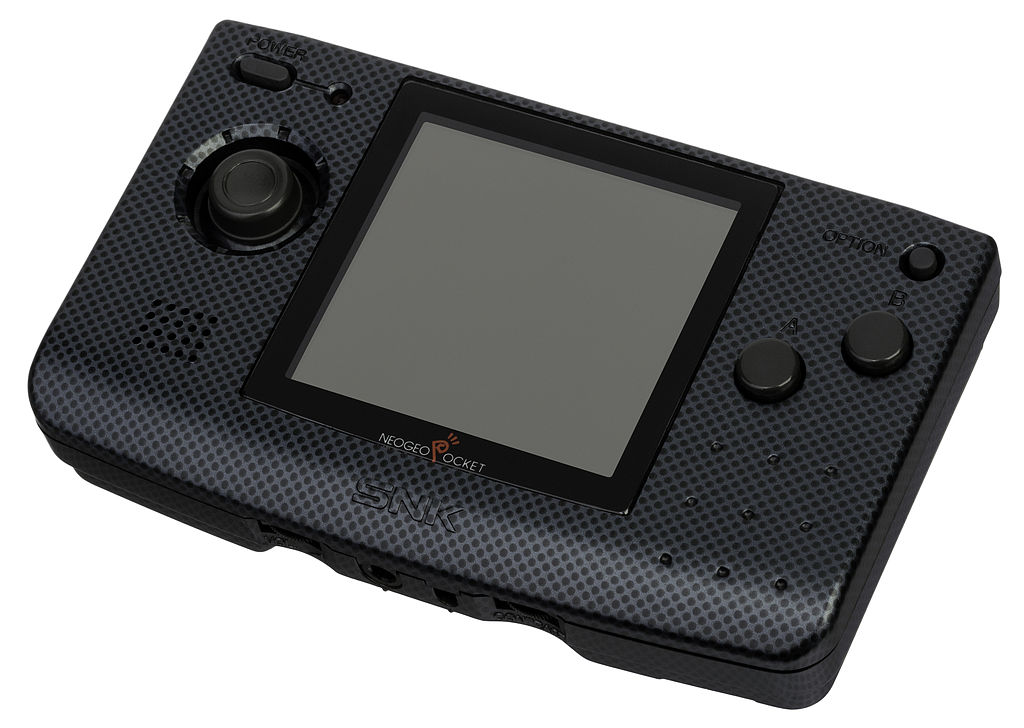
As I said above, the Neo Geo Pocket was replaced by its color version. The total score of both consoles sold about two million.
The color version uses a 16-bit Toshiba TLCS-900H processor operating at 6.14 MHz. The resolution of the color display is 160 x 152 pixels.
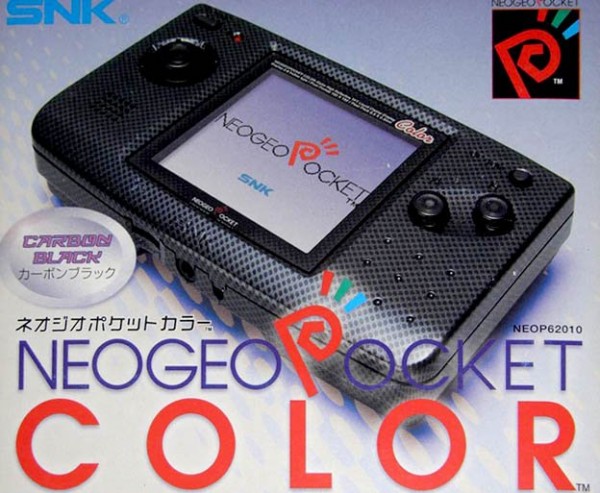
One of the most popular console games is Samurai Shodown 2.

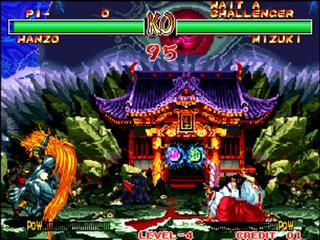
TV advertising.
Funny slogan - "Get pocket power."
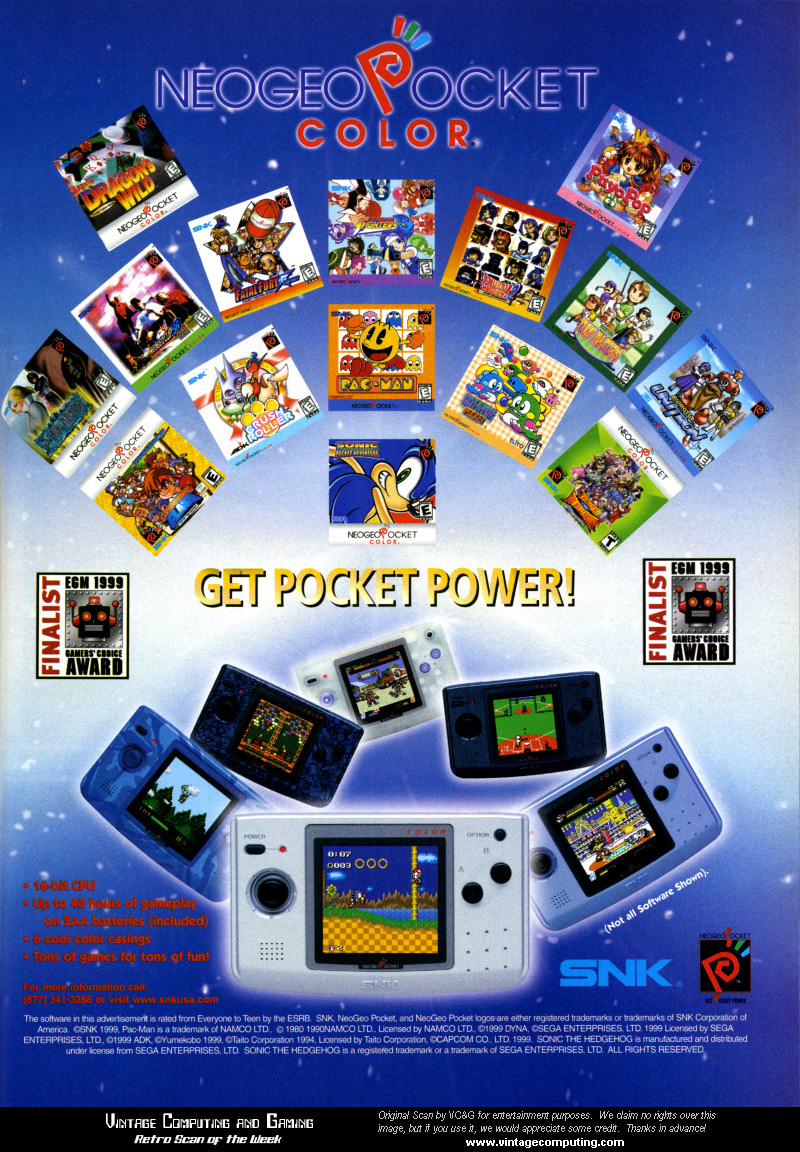
The WonderSwan portable console came out in 1999 in Japan. She had to compete with Game Boy. Interestingly, the developer WonderSwan Gunpay Yokoy created for Nintendo the original Game Boy - that is, he played in the "share the market."
One of the interesting features - the games were made for both the vertical screen layout and the horizontal one.

As with the Neo Geo, the WonderSwan console quickly replaced the color version — it was released in 2000. Interestingly, at the peak of popularity, two versions of the WonderSwan captured 8% of the Japanese gaming market, really competing with Nintendo.
The reason for such popularity was, firstly, the price - it is only about $ 60. Secondly, cooperation with Square bore fruit: Final Fantasy, Final Fantasy II, Final Fantasy IV and The Final Fantasy Legend were released for the console.
This is the fourth Final Fantasy.
Advertisement Final Fantasy II.
Advertise the game Detective Conan.
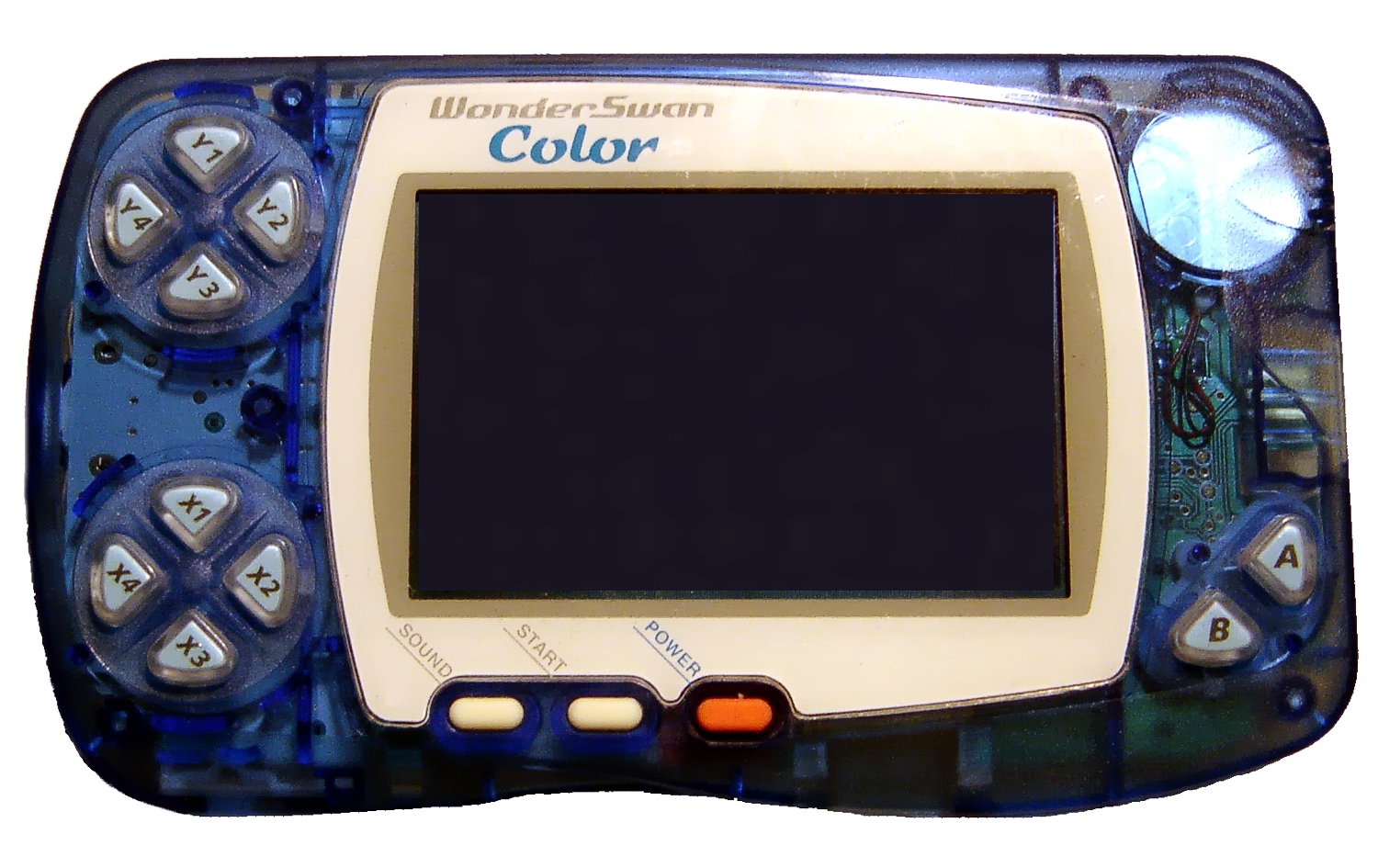
It is interesting:
History of portable game consoles. Part 1 (Until 2000)
The history of game consoles in advertising. Part 1: From Magnavox Odyssey to Super Nintendo
The history of game consoles in advertising. Part 2
The history of game consoles in advertising. Part 3
Alternative GDC Arcade: Home-Made Freak Controllers Gallery
Motion control in games
In the comments to my article The history of portable game consoles. Part 1 (Until 2000) you indicated to me the absence of some game consoles that were available in the 1990s. Therefore, I wrote this supplement.
The list of consoles this time:
- Brick game
- Sega nomad
- Game.com
- Visual Memory Unit for DreamCast
- Neo Geo Pocket
- Neo Geo Pocket Color
- WonderSwan
- WonderSwan Color
')




Brick game
I wonder if there are people in Habré who have never played Brick Game? In common, this toy was called Tetris. Contained from two to infinity games. As it turned out recently, it is possible to finish Tetris in order to increase the number of games - read this habrapost .
Powered by two finger batteries. Form factors - a wild number: now the Chinese are stylizing it for other consoles and for mobile phones. And, of course, the classic "brick", so popular in the 1990s in Russia. Sold so far.
The popularity of the toy has declined due to other consoles.

Sega nomad
I told about the Sega Game Gear in the last article, but I missed Sega Nomad. Although now this prefix is one of the most popular among rare consoles, as one reader noted.
The console is equipped with a 3.5-inch color display and a removable compartment for six finger-type batteries.
One of its main features - the lack of games created specifically for her. Instead, it was necessary to insert cartridges from the usual Sega Mega Drive / Genesis home console into the console. I think many owners of Shogi have dreamed of this. In addition, it was possible to connect this set-top box to the TV, insert an ordinary joystick from a shogi into a special port and play together. Interestingly, even when connected to a TV on the display, you can watch the game.



Virtual boy
By portable consoles can be attributed, and Virtual Boy, released in 1994 by Nintendo. Although for this console, after all, a table was needed, and it cannot be used while moving - because it blocks peripheral vision.
It was the first console from Nintendo, capable of three-dimensional graphics. It uses technology similar to the “virtual reality helmet” - you immerse your face in the device, and two monochrome (black and red) projectors transmit the image separately for each eye.
The system has a resolution of 384x224 pixels, although it does not contain a full LED matrix with this resolution. Instead, two 1x224 lines move at high speed.
The system expected failure. The users mostly had a neck pain. Yes, and the black and red image is not pleased.



Game.com
Portable console Game.com was released in 1997. Only 300,000 copies were sold - so-so results. But, nevertheless, this toy carried a number of interesting things in itself:
1) Touchscreen black and white display with adjustable contrast.
2) Two slots for cartridges.
3) Port for connecting to a modem.
4) Ability to connect to the outlet.
In the kit was a stylus: it is he at the bottom of the front panel.

Overview of the console in English.
Among the games released for this console were Duke Nukem 3D, Mortal Kombat Trilogy and Resident Evil 2. In this video - the gameplay of Resident Evil 2. Yes, yes, on the black and white display.

Visual Memory Unit for DreamCast
In 1998, the fifth prefix of the Sega company, named DreamCast, was released. For it is issued a memory card Visual Memory Unit. The map is not quite ordinary: it is equipped with a 48 x 32 dot LCD monochrome display, and the ability to play mini-games directly on it. In the case of Resident Evil, this map showed health - so it was not necessary to go to the “Weapon” menu during the game. VMU was inserted directly into the joystick.
More about DreamCast I wrote in the history of game consoles in advertising. Part 3

An example of using VMU in the game Sakura Wars III.
Sony Pocket Station
Another example of using a memory card as a separate gaming device is the Pocket Station device released by Sony in 1999.
The device is equipped with a liquid crystal display and a speaker. There is also a clock and a calendar. Information users can share via infrared. Toys for Pocket Station are recorded from discs with games.
The resolution of the monochrome display is 32 x 32 dots.
Pocket Station was released in the Japanese market and did not appear in Europe and the USA.
A mimic ad with a monkey.

Neo Geo Pocket
The Neo Geo Pocket portable console was released in 1998 in Japan and several other Asian countries without seeing the European and American markets. She lived until 1999, when she was replaced by a color version.
The console used a 16-bit Toshiba TLCS-900H processor operating at 6.14 MHz. The display resolution was 256x256 pixels.

Neo Geo Pocket Color
As I said above, the Neo Geo Pocket was replaced by its color version. The total score of both consoles sold about two million.
The color version uses a 16-bit Toshiba TLCS-900H processor operating at 6.14 MHz. The resolution of the color display is 160 x 152 pixels.

One of the most popular console games is Samurai Shodown 2.


TV advertising.
Funny slogan - "Get pocket power."

WonderSwan
The WonderSwan portable console came out in 1999 in Japan. She had to compete with Game Boy. Interestingly, the developer WonderSwan Gunpay Yokoy created for Nintendo the original Game Boy - that is, he played in the "share the market."
One of the interesting features - the games were made for both the vertical screen layout and the horizontal one.

WonderSwan Color
As with the Neo Geo, the WonderSwan console quickly replaced the color version — it was released in 2000. Interestingly, at the peak of popularity, two versions of the WonderSwan captured 8% of the Japanese gaming market, really competing with Nintendo.
The reason for such popularity was, firstly, the price - it is only about $ 60. Secondly, cooperation with Square bore fruit: Final Fantasy, Final Fantasy II, Final Fantasy IV and The Final Fantasy Legend were released for the console.
This is the fourth Final Fantasy.
Advertisement Final Fantasy II.
Advertise the game Detective Conan.

It is interesting:
History of portable game consoles. Part 1 (Until 2000)
The history of game consoles in advertising. Part 1: From Magnavox Odyssey to Super Nintendo
The history of game consoles in advertising. Part 2
The history of game consoles in advertising. Part 3
Alternative GDC Arcade: Home-Made Freak Controllers Gallery
Motion control in games
Source: https://habr.com/ru/post/228631/
All Articles